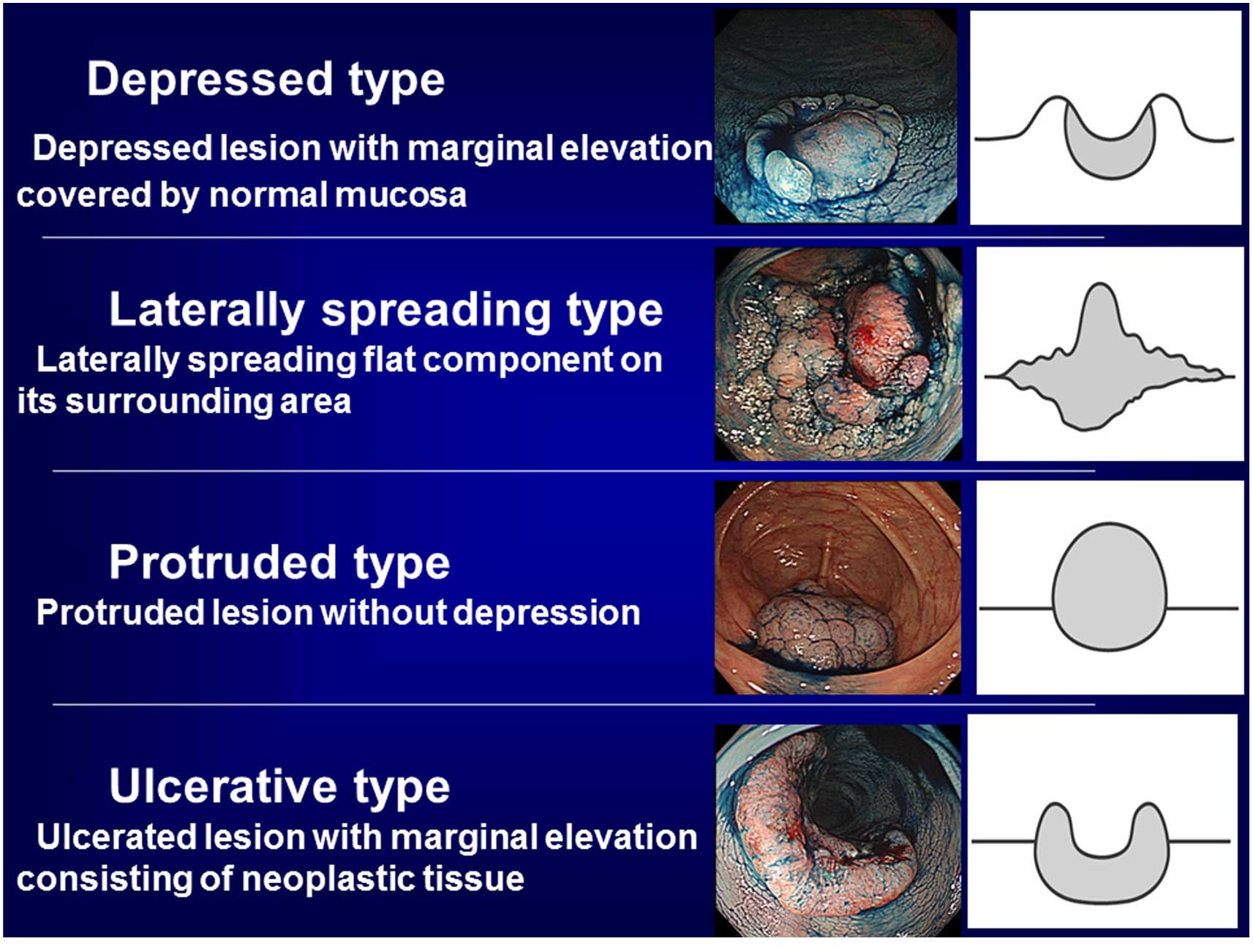Morphology as a risk factor for the malignant potential of T2 colorectal cancer
- Authors:
- Yuichi Mori
- Shin‑Ei Kudo
- Shungo Endo
- Chiyo Maeda
- Shumpei Mukai
- Yasuharu Maeda
- Shinichi Kataoka
- Kenichi Takeda
- Katsuro Ichimasa
- Hideyuki Miyachi
- Naruhiko Sawada
- Eiji Hidaka
- Fumio Ishida
View Affiliations
Affiliations: Digestive Disease Center, Showa University Northern Yokohama Hospital, Yokohama 225-8503, Japan, Department of Coloproctology, Aizu Medical Center, Fukushima Medical University, Aizuwakamatsu 965-0803, Japan
- Published online on: July 7, 2016 https://doi.org/10.3892/mco.2016.951
-
Pages:
223-226
Metrics: Total
Views: 0 (Spandidos Publications: | PMC Statistics: )
Metrics: Total PDF Downloads: 0 (Spandidos Publications: | PMC Statistics: )
This article is mentioned in:
Abstract
Currently, depressed type T1 colorectal cancer is often detected and its malignant potential is being revealed. However, few reports have focused on the morphology of T2 colorectal cancer types. The aim of the present retrospective study was to clarify the characteristics of colorectal T2 cancer types derived from depressed type T1 cancer. The present study included 195 patients with colorectal T2 cancer surgically resected at a referral hospital between April 2001 and April 2009. A total of 48 lesions (25%) with lymph node metastasis and 4 (2%) with distant metastasis were found. The lesions were classified by their form during endoscopy into four categories: Group A, depressed type (the periphery consists of normal mucosa); group B, laterally spreading type; group C, protruded type; group D, ulcerative type (the periphery consists of neoplastic mucosa). Tumor size, lymphatic and venous involvement, lymph node metastasis, and distant metastasis were compared between the four categories. The distribution of patients were as follows: Group A, 73 (37%), group B, 26 (13%), group C, 24 (12%) and group D, 72 (37%). The average tumor size for each category was 23, 51, 30 and 36 mm for groups A, B, C and D, respectively. The number of positive findings for lymphatic involvement, venous involvement, lymph node metastasis and distant metastasis for each category were: Group A, 50 (69%), 54 (74%), 19 (26%) and 1 (1%); group B, 14 (54%), 12 (46%), 8 (31%) and 0 (0%); group C, 14 (58%), 8 (33%), 6 (25%) and 0 (0%); group D 35 (49%), 41 (57%), 16 (22%) and 3 (4%). Group A demonstrated a significantly smaller tumor size (P<0.01), and higher rates of lymphatic and venous involvement (P=0.0333 and P=0.0019, respectively). No significant differences were observed between categories with regards to nodal and distant metastases. Of the T2 cancer types, ~40% were the depressed type. Compared with the other forms, depressed type lesions exhibited a smaller tumor size, and higher rates of lymphatic and venous involvement, which suggested these lesions were of a more malignant nature.
View References
|
1
|
Kudo SE, Takemura O and Ohtsuka K: Flat
and depressed types of early colorectal cancers: From East to West.
Gastrointest Endosc Clin N Am. 18:581–593. 2008. View Article : Google Scholar : PubMed/NCBI
|
|
2
|
Kudo Se, Lambert R, Allen JI, Fujii H,
Fujii T, Kashida H, Matsuda T, Mori M, Saito H, Shimoda T, et al:
Nonpolypoid neoplastic lesions of the colorectal mucosa.
Gastrointest Endosc. 68(4 Suppl): S3–S47. 2008. View Article : Google Scholar : PubMed/NCBI
|
|
3
|
Watanabe T, Itabashi M, Shimada Y, Tanaka
S, Ito Y, Ajioka Y, Hamaguchi T, Hyodo I, Igarashi M, Ishida H, et
al: Japanese society for cancer of the colon and rectum (JSCCR)
guidelines 2014 for treatment of colorectal cancer. Int J Clin
Oncol. 20:207–239. 2015. View Article : Google Scholar : PubMed/NCBI
|
|
4
|
Adachi, Yasuda, Kakisako, Sato, Shiraishi
and Kitano: Histopathologic characteristics of advanced colorectal
cancer smaller than 2 cm in size. Colorectal Dis. 1:19–22. 1999.
View Article : Google Scholar : PubMed/NCBI
|
|
5
|
George SM, Mäkinen MJ, Jernvall P, Mäkelä
J, Vihko P and Karttunen TJ: Classification of advanced colorectal
carcinomas by tumor edge morphology: Evidence for different
pathogenesis and significance of polypoid and nonpolypoid tumors.
Cancer. 89:1901–1909. 2000. View Article : Google Scholar : PubMed/NCBI
|
|
6
|
Goi T, Kawasaki M, Hirono Y, Katayama K
and Yamaguchi A: Clinicopathological analysis of invading
muscularis propria (T2) cancers < or=20 mm in diameter. Int
Surg. 93:1–5. 2008.PubMed/NCBI
|
|
7
|
Miyamoto S, Boku N, Fujii T, Ohtsu A,
Matsumoto S, Tajiri H, Yoshida S, Arai T, Ono M, Hasebe T and
Ochiai A: Macroscopic typing with wall stricture sign may reflect
tumor behaviors of advanced colorectal cancers. J Gastroenterol.
36:158–165. 2001. View Article : Google Scholar : PubMed/NCBI
|
|
8
|
Zhang H, Chen CS, Cong JC, Qiao L,
Hasegawa T and Takashima S: Clinicopathological characteristics of
advanced colorectal cancer 30 mm or smaller in diameter. Chin Med
Sci J. 22:98–103. 2007.PubMed/NCBI
|
|
9
|
Morson BC: Precancerous and early
malignant lesions of the large intestine. Br J Surg. 55:725–731.
1968. View Article : Google Scholar : PubMed/NCBI
|
|
10
|
Shimoda T, Ikegami M, Fujisaki J, Matsui
T, Aizawa S and Ishikawa E: Early colorectal carcinoma with special
reference to its development de novo. Cancer. 64:1138–1146. 1989.
View Article : Google Scholar : PubMed/NCBI
|











